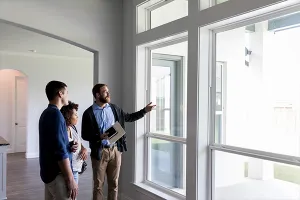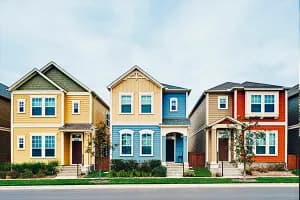
A house with a stylish, functional kitchen remains at the top of many homeowners’ wish lists. Some want the latest in popular woods or stains for cabinetry while others might fancy new appliances that cook faster and smarter while utilizing less energy. For others, it’s countertops and lighting that pique their interest.
But costs for such choices add up, and most real estate and design pros recommend that homeowners seek advice—from kitchen experts, consumer reports or their own sleuthing—before making decisions. Experts disagree about what trends are worth pursuing and even the definition of a trend. For designer Ginger Curtis of Urbanology Design, the best trends have staying power and add long-term value to a home.
Beyond Granite and Quartz for Counters
Quartz lost some cachet, due to safety issues from the silica dust, and Granite has been deemed a dated, overused material.
Sandya Dandamudi, president and owner of GI Stone, says natural quartzite and sintered stones like Dekton and Neolith are the rising stars for countertops. These stones consist of recycled and compressed bio-resins, some of which come in multiple colors and finishes. Among Dandamudi’s favorite choices is Iceberg quartzite, which is translucent, can be backlit and won’t stain or etch.

On the higher end, marble is still in style, despite some fearing how it looks if scratched or etched. Curtis thinks it becomes more beautiful as it gains patina. On installation trends, Dandamudi suggests installing the same countertop material along a backsplash for a seamless “counter splash.”
Storage Goes Dark
Storage space is still in high demand, but the ever-popular open kitchen usually means one less wall for cabinets or shelves. Mel Elion of Mel Elion Design says one trend that helps overcome this challenge is stacked cabinets above refrigerators and double ovens. Another, says designer Jodi Swartz of KitchenVisions, is putting pantries toward the back of the kitchen to create more space.

Swartz says storage appearance is trending toward richer wood colors like walnut, cherry and oak. Dark-painted finishes, even black, are popular as well, says designer Jenny Zalkin of Fine Zalkin Interiors. To make a dark palette work best, Zalkin favors them in rooms with lots of natural light.
More Personalization
Homeowners want the kitchen to feel like a distinct space that reflects their personalities, says designer Nancy Jacobson of Kitchen Design Partners. She notes that dressing up a kitchen to fit a homeowner’s personal style is a long-term trend. “We personalize their space with organizational accessories, multiple cabinet finishes, multiple metal finishes, texture, color and contrast,” she says.
When it comes to cabinets, the 2024 Kitchen Trends report by Houzz asserts that white is still the favorite, but favor for wood and greens are inching forward. Blue remained a top pick as well.

Curtis says her clients are less worried about resale and more interested in transforming their space with color. Now trending, she says, is the return of classy, 1930s dark green. She also sees personalization in lighting with bolder, modern shapes, which she’s incorporated in a new collection for Blueprint Lighting.
Greater Comfort
Kitchen users want to feel comfortable as they pursue their tasks. “This is one of the reasons the open kitchen concept continues to be strong since the adjoining living areas help make the kitchen work areas more comfortable,” says kitchen designer Mick De Giulio of de Giulio Design. Because so many of the surfaces in kitchens are hard so they withstand wear and tear, softer materials like hand-scraped floors offer a soft visual contrast, De Giulio says.

Sustainability in Materials and Tech
Sustainable materials, like stone, reclaimed and other woods, metals, glass and bamboo, have become more popular. Locally sourced materials are also popular since they minimize carbon footprint, says Sharon McCormick of Sharon McCormick Design. Many smart appliances appeal to the sustainably inclined as well, including the HydroTap, which has the power to release boiling water, chilled water and sparkling water in an instant.
Features for Aging in Place
With continued interest in staying put in a home, more design pros and clients are making rooms safer, particularly kitchens and bathrooms, by installing accessible features. Top on the list include:
- Pull-out cabinets
- Additional light layers for different tasks and moods
- Wide drawer pulls that are easier to grasp
- Nonslip flooring
- Replacing steps with ramps
- Cabinets at different heights to fit a wheelchair under
- Appliances with knobs in the front
- Rounded countertop edges
Changes That Pack a Punch
Sometimes, an entire overhaul isn’t in the cards, or maybe it isn’t wanted at all. Here are some lowkey changes that make a big difference.
Appliance Overhauls. Not a small change, per se, but more homeowners prefer to replace all appliances during a renovation, according to Houzz, and when they switch out equipment, they seek smart options with Wi-Fi connectivity and app integration.
Rounded Corners. With so many rectilinear lines, rounded corners and radiuses are making their way onto kitchen islands and countertops with bull-nosed rather than square edge profiles. “It adds a contemporary look but should be introduced sparingly so it doesn’t become overkill,” Zalkin says.

Still Bigger Islands. Houzz noted in its report that more than two in five homeowners opted for islands over 7 feet long. With room for five or six to sit at an island, Swartz says a separate dining table can be eliminated.
Taller Backsplashes. Backsplashes are expanding to the base of wall cabinets or a range hood and up to the ceiling, according to the Houzz report. The most common materials are ceramic or porcelain tile, followed by engineered quartz and natural stones. McCormick sees more artistic statements within backsplashes for contrast and texture such as copper mirror tiles, stone veneer, retro geometric patterns.









